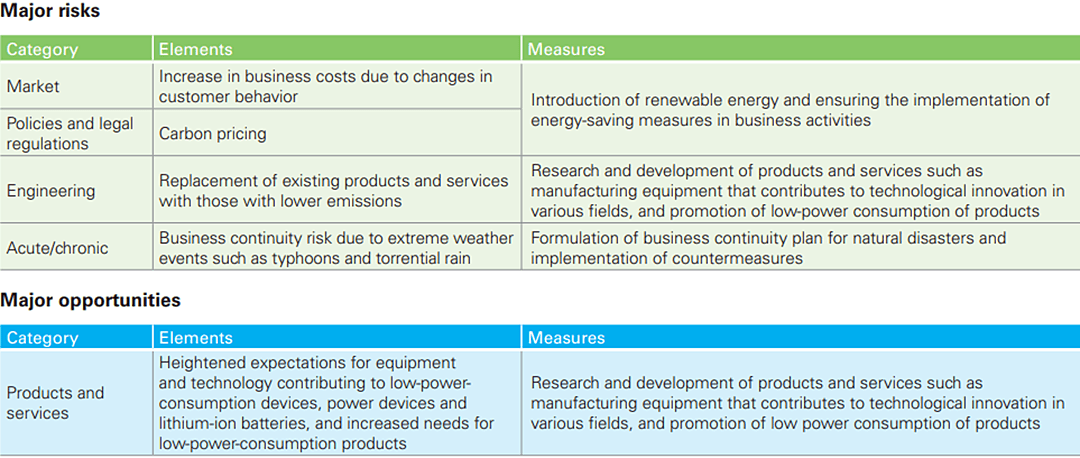Initiatives to Address Climate Change
Under the Environmental Policy, we offer products that enable our customers to contribute to environmental protection. Initiatives of the ULVAC Group are described below.
"B" Score Received in CDP "Climate Change Report 2023"
ULVAC, Inc. received a "B" score in the "Climate Change Report 2023" published by CDP, an international non-profit organization that manages an environmental information disclosure system.
CDP collects and analyzes information disclosed by companies and municipalities around the world through questionnaires on climate change and water resource protection, and grades their efforts on an eight-point scale (A, A-, B, B-, C, C-, D, D-). Our current grade of "B" indicates environmental management, and signifies that we are "aware of our company's environmental risks and impacts, and are acting accordingly."
We also received a "C" score in CDP's "Water Security Report 2023."
We will continue to promote environmentally friendly business activities to realize a sustainable society.
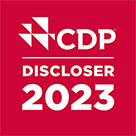
Response to the Recommendations of the Task Force on Climate-related Financial Disclosures (TCFD) and Climate Change Initiatives
ULVAC positions climate change initiatives as one of its key management issues. The ULVAC Group has set medium- to long-term greenhouse gas emission targets, namely, a 40% reduction in 2030 (compared with 2020) and effectively zero in 2050. We will take action to mitigate climate change by endeavoring to curb greenhouse gas emissions throughout our activities, such as by doing our utmost to conserve energy in Japan and overseas, introducing renewable energy with low greenhouse gas emissions, and developing environmentally friendly products. We endorse the recommendations of the Task Force on Climate-related Financial Disclosures (TCFD) and strive to disclose relevant information. Furthermore, ULVAC has been responding to a survey conducted by CDP*, an international NGO.

*CDP: A non-governmental organization (NGO) managed by a British charity. CDP sends questionnaires on climate change and other issues to companies and local governments and assesses and discloses the impact of their activities on the environment. When deciding which companies to invest in, CDP scores are considered important criteria.
Governance
Under the supervision of the Board of Directors, the Executive Officers in charge of sustainability and the environment monitor progress toward targets.
- ・ Meetings of the Sustainability Promotion Committee attended by the internal directors, executive officers, and department heads are held twice each year to acknowledge social trends and the Company's current condition, and discuss measures to address any issues. If significant issues related to management arise, the Management Council and the Board of Directors deliberate and make management decisions as needed.
- ・Meetings of the Global Environmental Management Committee chaired by the Executive Officer in charge of the environment and attended by environmental managers of Group companies are held twice each year. The committee monitors the setting of targets of each Group company and the progress, checks the status of the initiatives for achievement of the targets, discusses measures corresponding to the issues, and reports to the Management Council. The statuses of these initiatives are monitored by the Sustainability Promotion Committee and reported to the Board of Directors by the Executive Officer in charge of sustainability.
Strategy
Under the scenarios announced by the Intergovernmental Panel on Climate Change (IPCC), the International Energy Agency (IEA), and others, that "the global average temperature will rise by 4°C or more" and "the global average temperature rise will be kept below 2°C (partly up to 1.5°C) as agreed by the Paris Agreement," we identified business risks and opportunities in the medium to long term that will be brought about by climate change. Of these, we analyzed risks and opportunities with respect to "carbon pricing," "business continuity risk due to the occurrence of disasters caused by typhoons, torrential rain, and other extreme weather events," and "expansion of market opportunities for power devices" and evaluated quantitative impacts on our business. Going forward, we will expand the scope of quantification of impacts on business and further consider specific measures.
Risk Management
- ・ The Management Planning Department is designated as the department in charge of all risks that may cause serious damage to management. The Management Planning Department instructs the relevant internal divisions and departments and Group companies to identify such risks and formulate countermeasures. In this way, risks are identified, Group-wide responses are promoted, and the results are reported to the Risk Management Committee. The Risk Management Committee conducts detailed identification or identification of these risks and considers business reporting and remedial measures, strives for early detection through monitoring, conducts reporting, and implements remedial measures. Moreover, the Sustainable Management Department is designated as the department in charge of medium- to long-term sustainability risks. The Sustainable Management Department instructs the relevant internal divisions and departments and Group companies to identify sustainability-related risks and reports the results to the Sustainability Promotion Committee. The Sustainability Promotion Committee manages the progress of initiatives for medium- and long-term risks. Finally, the Board of Directors receives reports from these committees and oversees the status of risk management. Through these structures, the Group aims to achieve management stability and sustainable growth.
- ・ We have major development and manufacturing sites in Japan, which account for 60% of the Group's total GHG emissions in Scope 1 and 2. In addition, sites in South Korea account for 17% of the Group's total GHG emissions in Scope 1 and 2, making that country second only to Japan, and they are key sites for the Group's semiconductor business to which great importance is attached from the viewpoint of management strategy. Therefore, future introduction of carbon taxes and tightening of emissions trading regulations in Japan and South Korea would have significant impacts on costs. Thus, based on the ULVAC Group's GHG emissions in Japan and South Korea, we estimated and confirmed the amounts of impacts in 2030 under the Announced Pledges Scenario (APS), which is one of the scenarios presented in the IEA's World Energy Outlook 2021 and is a scenario that reflects volunteer countries' ambitious pledges. Reductions of GHG emissions at these sites are important for achieving the Group's goal of carbon neutrality. Therefore, a committee headed by the Executive Officer in charge of the environment and related divisions will monitor the risk of energy cost increases and continue to assess this and other risks, for which purpose it will monitor trends. In addition, we will promote initiatives for further energy saving and introduction of renewable energy.
- ・For Scope 3, environmental impacts in the value chain are significant upstream in procurement from suppliers and downstream in the use of products by customers. Therefore, mindful of the importance of providing environmentally friendly products, we are promoting initiatives to reflect environmental considerations from the development stage onward.
- ・ In formulating a business continuity plan, we assumed the occurrence of disasters caused by typhoons, torrential rain, and other extreme weather events, and are implementing measures to ensure continuing operation of our business.
-
In order to actively address climate issues as a responsible member of society, the ULVAC Group has set medium-to long-term targets for GHG emissions from its business activities, namely, a 40% reduction in 2030 (compared with 2020) and effectively zero in 2050. We will take action to mitigate climate change by endeavoring to curb GHG emissions throughout our activities, such as by doing our utmost to conserve energy in Japan and overseas, installing solar power generation facilities, introducing renewable energy, and developing environmentally friendly products.
-
-
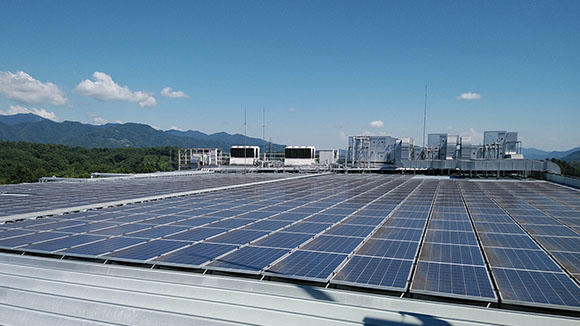
-
The ULVAC Group has introduced solar power generation systems and utilizes the power generated in its business activities. In FY 2022, we generated 1,564 thousand kWh, which contributed to the reduction of greenhouse gas emissions. We will continue to consider the active introduction of solar power generation systems and promote the use of renewable energy.
-
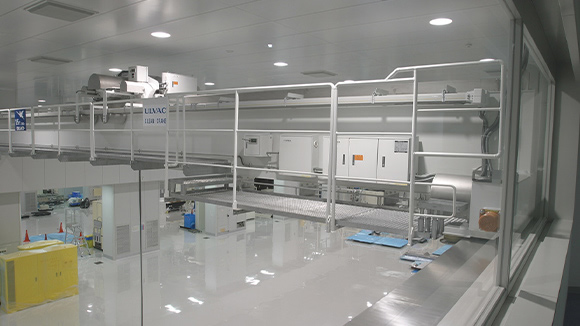
-
By providing air conditioners and airflow switching control, we have introduced a system that allows lowering the air conditioner fan power so that the airflow can be reduced to the minimum circulation flow rate when a clean room is not in operation, e.g. at night and on holidays, to maintain the cleaning capability.
-
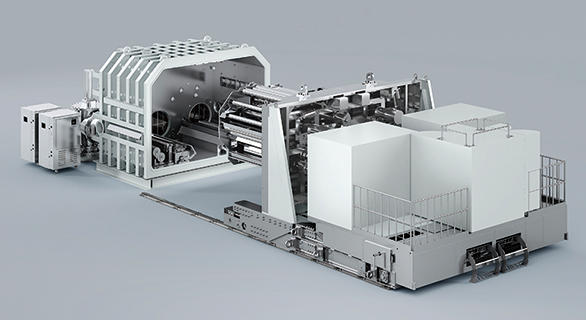
Large evaporation roll coater
-
We are stepping up our efforts to reduce greenhouse gas emissions and working to reduce not only ULVAC's but also our customers' power consumption through the use of ULVAC equipment.In particular, since large evaporation roll coaters use a lot of electricity, using energy efficiently is a priority. By installing measuring instruments, detailed power consumption of each process is determined in order to maximize overall efficiency of energy use.Going forward, we will analyze the trend of power consumption of each process by comparing the collected data with the log data of the equipment with a view to further improving the equipment.
-
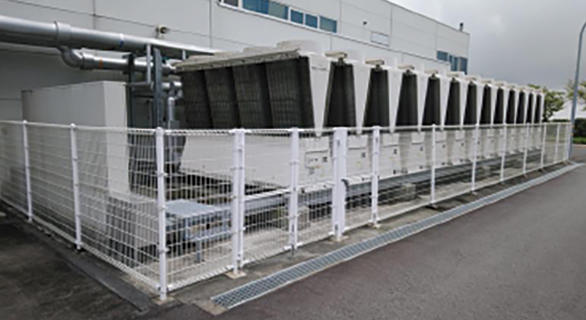
Cold/hot water heat source equipment
-
The cold/hot water heat source equipment at ULVAC's Fuji Susono Plant is a source of cold water for cooling manufacturing equipment as well as cold water and hot water used by the clean room's air-conditioning systems.From the viewpoint of reducing greenhouse gas emissions, temperature settings for cold water and hot water were adjusted corresponding to the cycle of the seasons. As a result, the Fuji Susono Plant reduced its annual greenhouse gas emissions by 47.65 tons.The Fuji Susono Plant will continue endeavoring to further reduce greenhouse gas emissions within the range of temperature control values for production activities and the clean room.
Metrics and Targets
Utilization of renewable energy
Solar power generation system
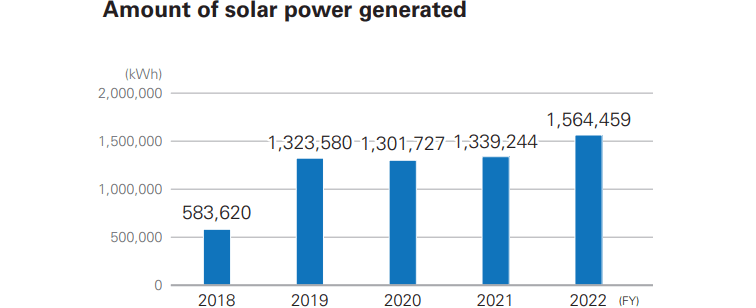
Office and Plants Initiatives
Clean Room Air Conditioner Circulating Airflow Switching Control
Analysis of power consumption of large evaporation roll coaters
Change of the temperature setting of the cold/hot water heat source equipment to save energy
Environment
This website use cookies to obtain and use access data to understand the convenience and usage of customers. If you agree to use cookies, click "I Accept".
[Privacy Plicy] [Cookie Policy]
